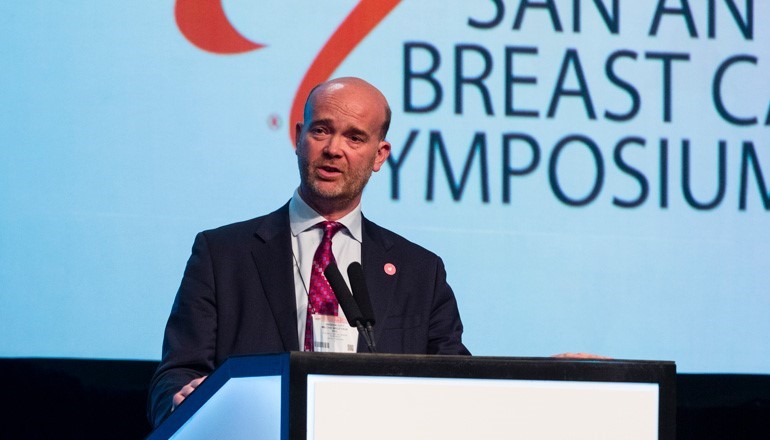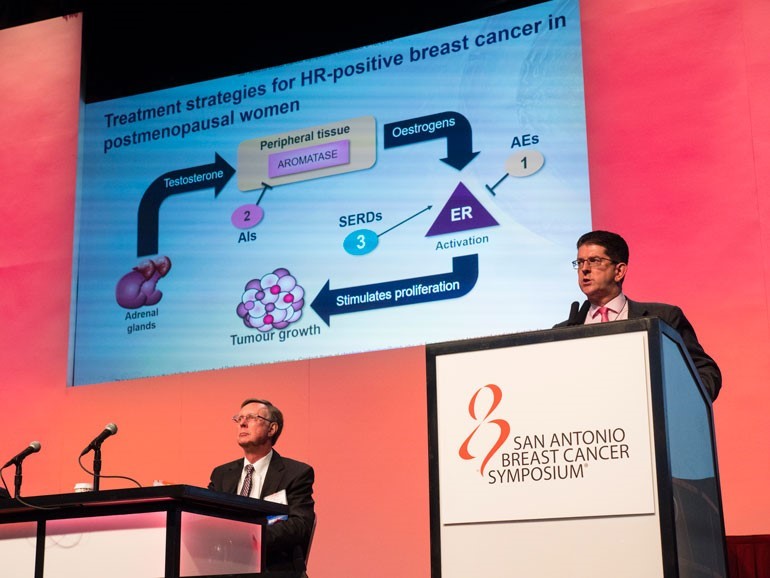Untangling the BRCA genes in triple negative breast cancer
Over the course of the week we heard from a range of experts about the pitfalls of treating triple negative breast cancer as just one subtype of the disease. Among these speakers was Professor Chuck Perou, a member of our Science Strategy Committee whose work at the turn of the millennium led to the identification of the triple negative subtype, but now argues instead that these tumours are so genetically diverse that they ought to be broken down into additional categories.
While the debate continued over which exact categories we should be using to study the disease, Professor Diana Eccles provided some food for thought from the POSH study, which has collected information from around 3,000 UK women diagnosed with breast cancer age 40 or under.
Of the many important questions the study was set up to answer, today we were finding out whether inheriting a BRCA gene mutation influences a woman’s chances of surviving breast cancer. This is important because it could help women make better informed choices about their treatment, for instance opting for more intensive treatment to improve their chances of overcoming the disease in the long-term.
The results were somewhat surprising: there was no overall difference in survival between women with and without mutations in their BRCA1 or BRCA2 genes. However, among women with triple negative breast cancer, they found that those with BRCA gene mutations had a better chance of being alive 10 years after their diagnosis: 76% Vs 66%. Whilst intriguing, these results came from only 511 women, meaning they were not statistically significant, so further research will be needed to confirm the findings.
#sabcs16: Prof Diana Eccles' POSH study of younger women: In triple negative, women with BRCA mutation had better survival at 10 yrs. #SABCS pic.twitter.com/Mt8XRfwRxU
— Breast Cancer Now (@breastcancernow) December 8, 2016
Another platinum-lining for BRCA mutation carriers
One of the biggest challenges we face in tackling breast cancer is a lack of treatments to target the triple negative form of the disease, and we recently celebrated some promising progress from our scientists led by Professor Andrew Tutt. Building further on our understanding of the role BRCA mutations play in triple negative breast cancer, we heard from Prof Tutt on the latest results from his Triple Negative Trial (TNT), which is part-funded by Breast Cancer Now.
The TNT has previously shown that women with BRCA gene mutations were more likely to benefit from treatment with carboplatin (a platinum-based chemotherapy drug) than the standard chemotherapy drug docetaxel. The new TNT analysis asked whether patients whose tumours contained ‘silenced’ or ‘methylated’ BRCA genes at the time of diagnosis were also more likely to benefit from carboplatin. This was not the case, however, suggesting that this ‘silencing’ of the BRCA genes at diagnosis might not be as informative as we previously thought, possibly because it can change over time unlike inherited mutations.
In a separate talk about drugs which are designed to take advantage of cancer cells’ weaknesses, Prof Tutt gave a possible explanation for these TNT findings. He argued that a primary breast tumour’s weaknesses might leave a ‘molecular scar’ on its subsequent secondary tumours, but by this stage in the evolution of the tumour, that weakness may no longer be driving the cancer’s growth, and drugs designed to target this weakness may no longer be effective.

Prof Andrew Tutt speaking at the 2016 San Antonio Breast Cancer Symposium. Photo Courtesy © SABCS/Todd Buchanan 2016
PARP inhibitor shows promise
In further promising news for women with BRCA-mutated tumours, the 290-patient ‘Brocade’ clinical trial found that adding the experimental PARP inhibitor veliparib to chemotherapy significantly improved the overall response rate among patients with locally recurrent or metastatic BRCA-mutated breast cancer, and didn’t result in any additional serious side effects. The results didn’t show a significant improvement in survival, but the researchers were hopeful that an ongoing larger study could demonstrate a boost to survival from the drug.
Getting to know the neighbours
Professor Clare Isacke, team leader at our Research Centre and star of our #MannequinChallenge, took to the stage to tell the global breast cancer community about her team’s progress in finding the early causes of breast cancer spread. Prof Isacke talked about the ‘healthy’ cells that surround and sometimes infiltrate a breast tumour, and how tumours rely on these cells to grow and spread. She has found that healthy cells in the tumour’s local ‘neighbourhood’ can change dramatically depending on the subtype of breast cancer, and stressed that we need to find out more about these differences as they could be influencing the way tumours respond to treatments like chemotherapy or anti-hormone drugs. Her team has had a busy year revealing the complex way that neighbouring cells assist breast cancer, in particular fibroblasts and pericytes.
In another fascinating insight into breast cancer’s local surroundings, we heard from Dr Shizhen Wang about the role of exosomes. Exosomes are little pockets of cell membrane that bud off from a cell’s surface, and take some of the contents of the cell with them. They can then move between cells, merge with the surface of neighbouring cells and release their contents. Scientists believe that cancer cells use this process as a communication network to interact with surrounding cells. For instance, Dr Wang’s experiments have demonstrated that tumour cells moving around the body release exosomes which turn certain tissues into hospitable environments for secondary tumours to develop.
Tackling secondary breast cancer in the clinic
Drawing on our understanding of the forces that drive secondary breast cancer, world-renowned clinician and researcher Professor Stephen Johnston from the Royal Marsden Hospital gave an overview of trials which are aiming to find more effective ways to keep hormone-positive secondary breast cancer under control. He highlighted the importance of combining drugs which target the different molecular pathways driving a cancer’s growth to improve the effectiveness of treatment and reduce the risk of drug resistance. These key pathways included the oestrogen production and signalling pathways (which can be blocked with aromatase inhibitors or tamoxifen) and the cell growth and replication cycles (blocked with drugs including palbociclib or everolimus).

Professor Stephen Johnston speaking at the 2016 San Antonio Breast Cancer Symposium. Photo Courtesy © SABCS/Todd Buchanan 2016
Taking stock
Reflecting on recent progress in our ability to keep secondary breast cancer at bay for longer, in one of the final talks of the conference we heard from Professor Matthew Goetz that 2016 had been the year of the CDK4/6 inhibitor, and he suggested that 2017 could well be the year of immunotherapies. We’re expecting to hear the outcomes from a number of immunotherapy trials next year, and we’ll have to wait and see whether they show positive results for women with secondary breast cancer.
As the ‘year in review’ talks came to a close, we were reminded of the remarkable progress we’ve made in understanding this ever more complex disease in 2016, and of the ongoing efforts which will achieve even more again next year. To all of our incredible supporters and scientists alike, we’d like to say a huge thank you for the discoveries you’ve made possible.
Find out more